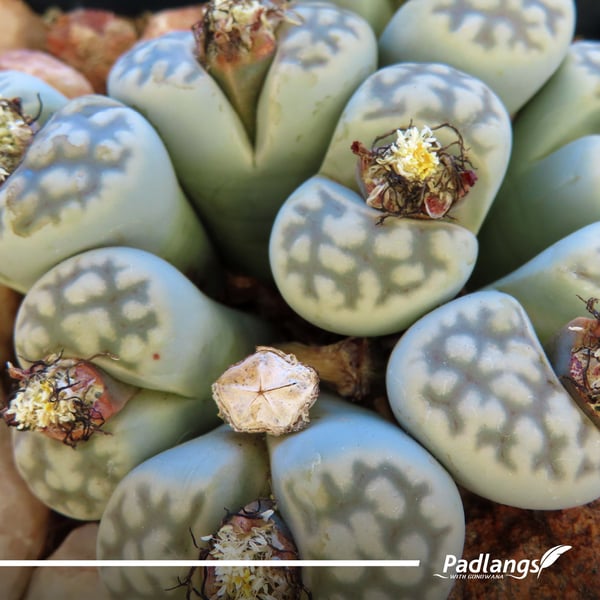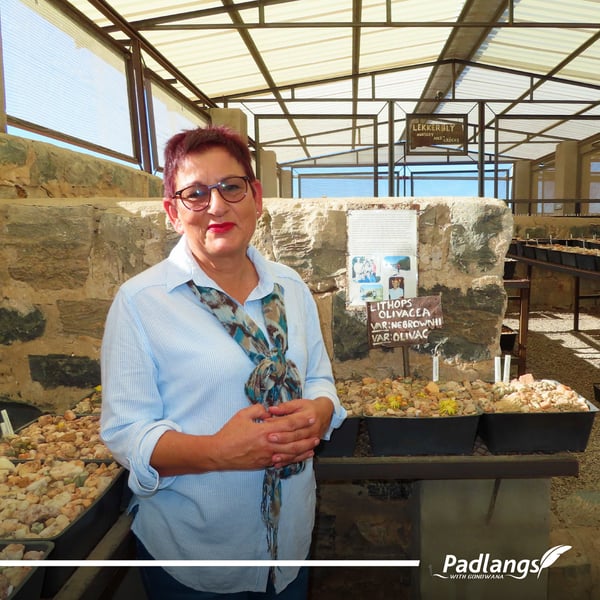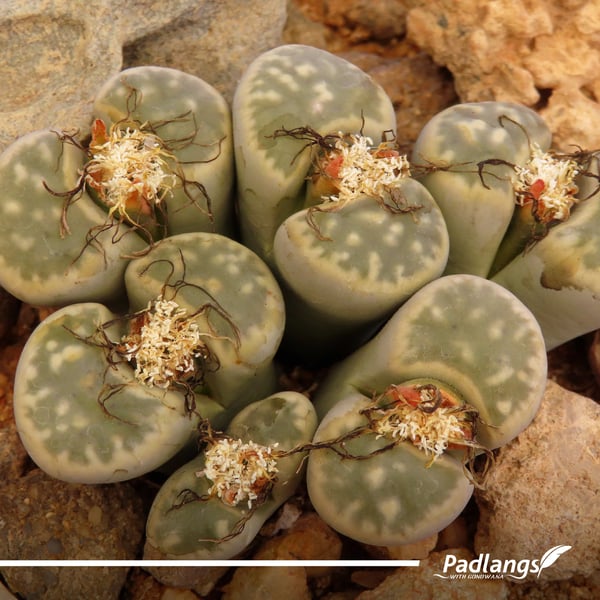There are untold treasures beneath our feet, lithops, the small stone-like succulents being one of them. Hilde Mouton, Namibia’s very own lithops ambassador, shared their story.

Sometimes also called ‘pebble plants’, ‘stone plants’ or ‘beeskloutjies’ (little cow hooves in Afrikaans), the lithops plant was described by botanist, explorer and artist William John Burchell in 1811 as a ‘curiously strange pebble’. He recorded that the plant ‘. . . in colour and appearance bore the closet resemblance to the stones between which it was growing’.
I had met Hilde and her husband Frikkie at Alte Kalköfen Lodge between Keetmanshoop and Lüderitz fifteen years ago when the lodge was built and was privileged to walk through Namibia’s first lithoparium and be introduced to Hilde’s collection. As one of the only people in Namibia with a permit to cultivate this intriguing and protected plant, Hilde was the perfect person to introduce me to lithops.
When I visited recently, I was amazed to find that the Cole Lithoparium, named after the ‘father of lithops’, Desmond Cole, had expanded threefold to now also include a collection of cultivars, an array of succulents from Namibia and South Africa, and a lithops nursery and creche. “They are like my babies,” she told me. And she cares for them as if they are, carefully propagating the miniscule seeds and tending them with love.

As we walked through the rows of lithops in their precisely-labelled trays, Hilde filled me in on all things lithops. These protected plants grow in the arid and semi-arid areas of central, southern and western Namibia, and northern South Africa. In Namibia, lithops are most prolific in the south around Warmbad, Grünau and Karasburg. There are forty species, four found in both Namibia and South Africa, and nineteen in Namibia, with fifteen of these being endemic.
“Winter is the resting time in nature,” Hilde informed me. “Lithops withdraw into the soil and can stay dormant under the soil for approximately eight years if there is no rain. After the first rains they reappear.”
After the long years of drought in Namibia, people told her that there were no lithops left in some areas. At the beginning of January and February, just before the rains started, she visited an area where there had previously been lithops growing and couldn’t see any plants. After the first 40mm of rain, she found a few plants and a week later 49 plants had emerged.
Showing me how lithops reacts to the miracle of water, she sprayed a fine mist onto a dry seed capsule. Within a few seconds it started to open. Depending on the species, each seed pod can hold from twenty to a thousand seeds, but in nature only 0.02 percent will germinate and become adult plants.

At the end of the rainy season in Namibia, which is around April and May, the delicate and beautiful lithops flowers appear, with a few species flowering two to three weeks later. The plants from the central part of the country in the Windhoek area start flowering first and the ones from Lüderitz and surrounds are the last to flower. And, interestingly, in the lithoparium they follow the same pattern.
Curious as how to gauge when the plants are thirsty, I asked her how often they need water and she replied that in the summertime she waters them every two to three weeks when they look wrinkled. She joked: “When they look like your grandmother’s face, you know it’s time to give them a little bit of water. They won’t die from less water, but they will die from too much water.” From years of experience as a lithops guardian, she watches the plants closely and knows that in winter when the old leaves start to die off, it’s time to give the plants a refreshing shower.
I also learned that lithops plants are long-lived if not disturbed. “Lying flat on your stomach in the veld, you can count the old dead leaves like the rings of the tree.” Lithops expert, Roy Earle has spent much time on his stomach and has counted 65.
Hilde also provides a helping hand to care for lithops in the wild. She is sometimes asked to offer advice at mining sites, transplanting plants when necessary, and reintroducing plants to areas where nothing remains due to past human activity, reestablishing new colonies. She and Frikkie are members of the Lithops Research & Conservation Foundation with several other dedicated lithops enthusiasts. Three times a year the team heads out into the field for three weeks identifying plants and noting their distribution for conservation purposes.
And how did she become interested in these small plants that are so hardy and sensitive at the same time? Hilde’s love affair with lithops began many years ago when her friend, Tok Schoeman, showed her a lithops plant that a farmer from the Koës area had brought to him. This ignited their passion, inspiring him and his wife, Denise, and Hilde and Frikkie to travel around the country searching for lithops. On one of their travels, they discovered a species not yet recorded, which was named ‘Amicorum’, meaning ‘Circle of friends’. She was hooked.
But, no matter how intriguing these plants are, she reminds the public that they are protected and urges people not to drive where there are no tracks, and not to dig up the plants in the wild, which can destroy a whole colony. To emphasise this, she relates a story about the Sandverhaar farm, where the Alte Kalköfen Lodge is located. In the mid-1920s, the former owner of the farm wrote to his friend in Germany, inviting his son, who was a well-known botanist, to come and see the plants and succulents growing in the area. He duly arrived with his wife and travelled by ox-wagon collecting plants. At one place in Karasburg, he wrote that they collected 250 plants in the morning and 250 plants in the afternoon. When the area was studied in 2003, eighty years later, there were less than twenty plants remaining; the entire colony had been disabled.
Hilde’s love for lithops is infectious and the fascinating plants reveal another jewel of the arid land. Not diamonds or gold, but glittering with all the wealth, secrets and wonders of the earth.


.png)
.jpg)
.jpg)




.png)

SUBMIT YOUR COMMENT